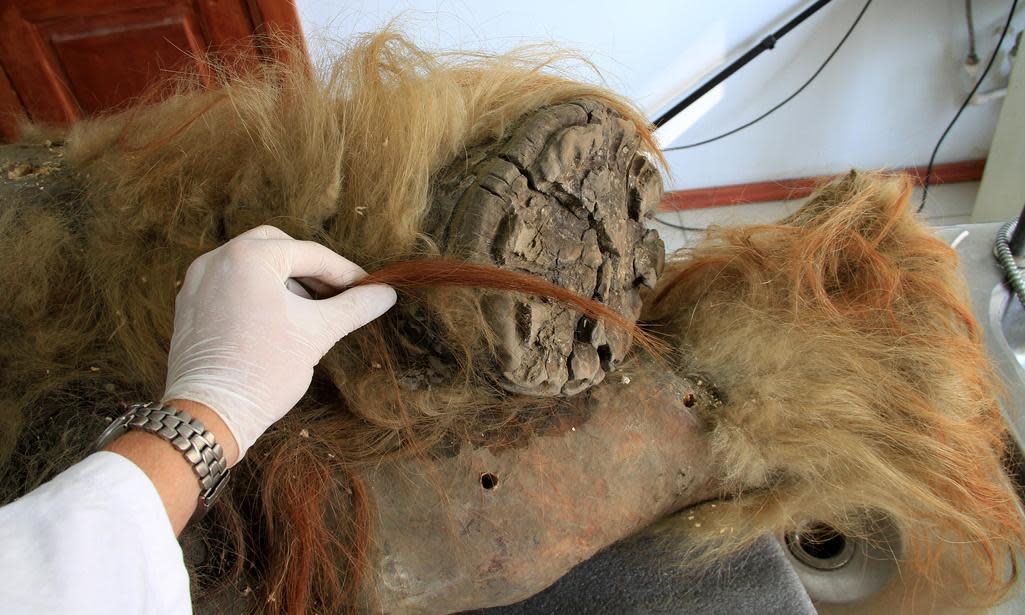Mulleted mammoth called Chris Waddle helps scientists crack creatures’ genetic code

Researchers have reconstructed the genetic code of the woolly mammoth in unprecedented detail after discovering fossilised chromosomes in the skin of a 52,000-year-old carcass preserved in the Siberian permafrost.
The mammoth’s lavish mane led researchers to name it after Chris Waddle, the mulleted former England footballer. It became freeze-dried on death, a process that preserved the 3D structure of the chromosomes in the animal’s skin.
Armed with the ancient genetic material, scientists were able to assemble the mammoth genome, determine that it had 28 pairs of chromosomes, and see genes that were switched on or off, details that are crucial for understanding what it meant to be a mammoth.
Prof Erez Lieberman Aiden, the director of the Center for Genome Architecture at Baylor College of Medicine in Houston, said the samples were “a new kind of fossil” that “preserved biomolecules for vast periods of time” and contained far more information than those studied before.
Dr Olga Dudchenko, also at Baylor, said the discovery of fossil chromosomes was a “gamechanger” because knowing the shape of an organism’s chromosomes made it possible to assemble the entire DNA sequence of an extinct creature, providing insights into their biology that were previously out of reach.
The international team of researchers tested dozens of samples over five years before striking gold with a piece of skin taken from behind the ear of a mammoth excavated in northern Siberia in 2018. They believe the animal’s skin spontaneously freeze-dried shortly after death, preserving the tissue through a similar process used to make beef jerky.
The mammoth was called Chris Waddle when scientists recovering the carcass noticed its impressive mane. “It’s not clear that it’s exactly the hairdo the mammoth had while it was alive,” said Dudchenko. “And it later turned out that the mammoth was female.”
Analysis of the skin revealed the 3D structure of the mammoth’s chromosomes was preserved in the dehydrated cells after being turned into a robust glass-like material. Once formed the fossil samples, labelled chromoglass, could endure for millions of years, the researchers wrote in the journal Cell. In a series of unusual tests, the researchers showed that the DNA could survive in tissues run over by a car, hit with a baseball or blasted from a shot gun.
Until now, ancient DNA recovered from extinct species has been highly fragmented. The snippets allow scientists to spot small-scale genetic differences between extinct animals and their living relatives, but little more. By contrast, the new samples contain hundreds of millions of letters of code, revealing the large-scale structure of the genome.
Beyond being able to assemble the mammoth’s genome and count its chromosomes, the scientists found that the arrangement of chromosomes inside the cells showed which genes were activated, including genes linked to woolliness and cold tolerance.
The work boosts plans to bring back the woolly mammoth, a feat researchers hope to achieve by rewriting the genome of an Asian elephant to match that of a mammoth. “Is it sufficient for de-extinction? Probably not,” said Prof Marc Marti-Renom at the National Centre for Genomic Analysis in Barcelona. “There’s quite a bit of work still to be done if someone wants to transform a modern elephant into a mammoth. It’s one step forward in that direction.”
The researchers are hoping to find more fossil chromosomes in other extinct animals and in Egyptian mummies, many of which may already exist in museum collections.
Prof Adrian Lister, a mammoth expert at the Natural History Museum who was not involved in the study, called the research “astonishing”.
“Ancient DNA research has, until now, relied on a ‘soup’ of small fragments of DNA extracted from ancient tissues,” he said. “The researchers have been able, in the case of this mammoth carcass preserved in arctic permafrost, to retrieve intact chromosomes with their DNA, and the chromatin protein essential to their function, intact.”
He added: “This new work opens up major new possibilities of exploring the biology of extinct species. This exceptional preservation might be found in fossils much older than the 51,000-year-old mammoth, back to 2 million years ago, opening the possibility to investigate the biology of much older extinct species and their relationship to and differences from living relatives.”


